Wistron NeWeb CB500AG 802.11a/b/g WLAN Cardbus Adapter User Manual FCC
Wistron NeWeb Corporation 802.11a/b/g WLAN Cardbus Adapter FCC
Users Manual
WLAN a+b+g Cardbus Adapter
User Manual
Version: 1.0
Feb 2003
1
Copyright Statement
No part of this publication may be reproduced, stored in a retrieval system, or
transmitted in any form or by any means, whether electronic, mechanical,
photocopying, recording or otherwise without the prior writing of the publisher.
Windows™ 98SE/2000/ME/XP are trademarks of Microsoft® Corp.
Pentium is trademark of Intel.
All copyright reserved.
2
Federal Communication Commission Interference Statement
This equipment has been tested and found to comply with the limits for a Class
B digital device, pursuant to Part 15 of the FCC Rules. These limits are
designed to provide reasonable protection against harmful interference in a
residential installation. This equipment generates, uses and can radiate radio
frequency energy and, if not installed and used in accordance with
the instructions, may cause harmful interference to radio communications.
However, there is no guarantee that interference will not occur in a particular
installation. If this equipment does cause harmful interference to radio or
television reception, which can be determined by turning the equipment off and
on, the user is encouraged to try to correct the interference by one of the
following measures:
- Reorient or relocate the receiving antenna.
- Increase the separation between the equipment and receiver.
- Connect the equipment into an outlet on a circuit different from that to which
the receiver is connected.
- Consult the dealer or an experienced radio/TV technician for help.
FCC Caution: To assure continued compliance, (example - use only shielded
interface cables when connecting to computer or peripheral devices) any
changes or modifications not expressly approved by the party responsible for
compliance could void the user's authority to operate this equipment.
This device complies with Part 15 of the FCC Rules. Operation is subject to the
following two conditions:
(1) This device may not cause harmful interference, and
(2) This device must accept any interference received, including interference
that may cause undesired operation.
RF EXPOSURE STATEMENT:
In August 1996 the Federal Communications Commission (FCC) of the United
States with its action in Report and Order FCC 96-326 adopted an updated
safety standard for human exposure to radio frequency electromagnetic energy
emitted by FCC regulated transmitters. Those guidelines are consistent with
the safety standard previously set by both U.S. and international standards
bodies.
The design of this device complies with the FCC guidelines and these
international standards. Use only the supplied or an approved antenna.
Unauthorized antennas, modifications, or attachments could result in violation
3
of FCC regulations. This device can not co-locate or operate with any other
transmitter.
Body-worn Operation
This device was tested with typical laptop computer with PCMCIA SLOT ON
EITHER SIDE OF THE COMPUTER FOR TYPICAL BODY-WORN OPERATIONS
with the device directly contacted to the human body to the back
and side of the laptop computer. To maintain compliance with FCC
RF exposure compliance requirements, maintain at least 1.5 cm to nearby
person.

4
Table of Contents
1. INTRODUCTION 5
1.1 KIT CONTENTS ........................................................................................................5
1.2 SYSTEM REQUIREMENTS.........................................................................................5
1.3 STATUS LED ............................................................................................................5
2. DRIVER/UTILITY INSTALLATION / UNINSTA LLATION 6
2.1 INSTALLATION .........................................................................................................6
2.1.1 ADDITIONAL SETUP PROCESSES.............................................................................9
2.1.2 VERIFYING THE DRIVER .........................................................................................9
2.2 UNINSTALLATION...................................................................................................11
3. CONNECTING TO AN EXISTING NETWORK 12
3.1 ADDITIONAL NOTE FOR WINDOWS XP ................................................................14
4. CREATING A NEW NETWORK 15
5. CONFIGURATION 17
5.1 DEVICE CONFIGURATION ......................................................................................17
5.1.1 NON-DEFAULT SETTINGS CONFIGURATION ..........................................................18
5.1.2 DEFAULT SETTINGS WINDOWS XP ZERO-CONFIGURATION .................................21
6. TROUBLESHOOTING 22
5
1. Introduction
Thank you for purchasing the WLAN a+g Cardbus Adapter that provides the easiest
way to wireless networking. This User Manual contains detailed instructions in the
operation of this product. Please keep this manual for future reference.
1.1 Kit Contents
l WLAN a+g Cardbus Adapter
l Installation Software CD
l Quick Start Guide
1.2 System Requirements
l A laptop PC contains:
- 32-bit Cardbus slot (or Desktop PC with PC Card-PCI adapter)
- 32 MB memory or greater
- 300 MHz processor or higher
l Microsoft® Win™2000/ME/98 Second Edition/XP
1.3 Status LED
There are 2 Status LEDs on the WLAN a+g Cardbus Adapter. You can check your
network connectivity status by looking at the LEDs.
l Off: Power off.
l Slow Blink: A connection is made. There is no activity yet.
l Fast Blink: There are activities in a connected network.
l Alternate Blink between LEDs: Look for a network association.
l One LED Blink: Power Saving Mode is on.
l One LED Steady Light: Awake from Power Saving Mode.
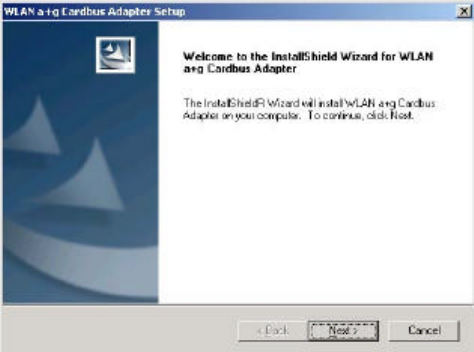
6
2. Driver/Utility Installation / Uninstallation
2.1 Installation
Note! The Installation Section in this User Manual describes the first-time installation
for Windows. To re-install the driver, please first uninstall the previously
installed driver. See Chapter 2.2 “Uninstallation” section in this User Manual.
Note! Do Not insert the Adapter into the Cardbus slot before the driver installation.
Note! If you have inserted the Adapter into the Cardbus slot before installing the
driver, a warning message pops up informing you that the software has not yet
been installed. Please click “Cancel” to close the warning message. Remove
the Adapter, and then start to install the driver.
Follow the steps below to complete the driver/utility installation:
1. Insert the Installation Software CD into the CD-Rom Drive.
2. Click “Next”.
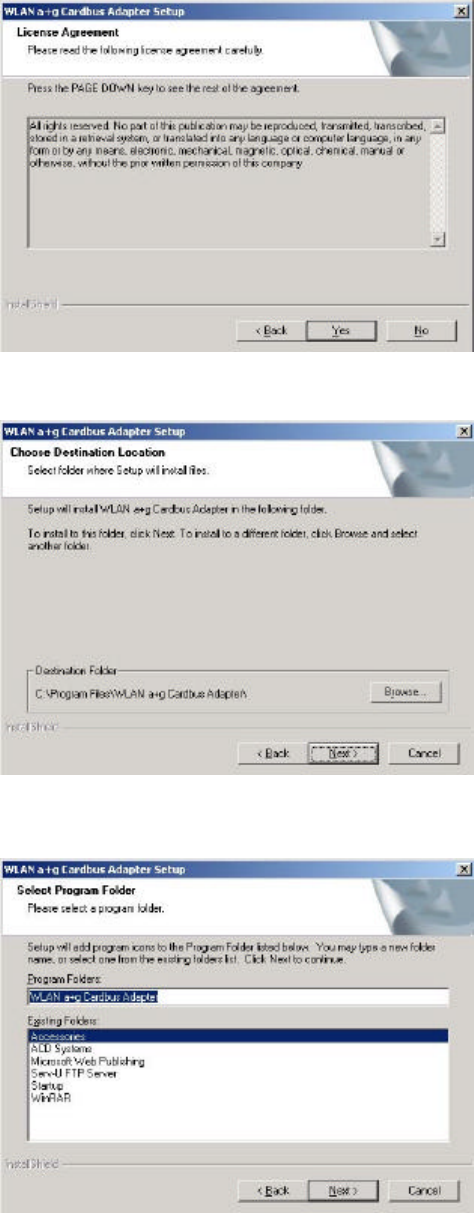
7
3. Read the License Agreement and click “Yes”.
4. Click “Next” to continue or click “Browse” to choose a destination folder.
5. Click “Next”.
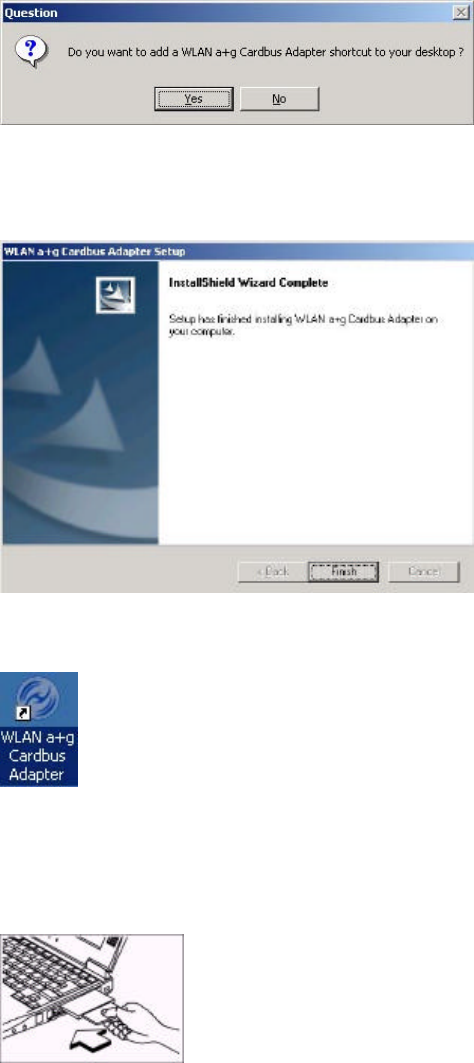
8
6. Click “Yes” to create a shortcut icon on your desktop.
7. Click “Finish”.
8. You should now see the shortcut icon on your desktop.
9. Insert the Adapter into the Cardbus slot, and the Windows Operating System will
find the new hardware and automatically install it. (For Windows 98SE or
Windows Me, please restart your computer before inserting the Adatper).
9
2.1.1 Additional Setup Processes
During software installation procedure, each operating system may prompt different
specific options:
1. Windows 98SE: The system will request the original Windows CD during the
installation process. When the installation is finished, you’ll have to restart your
computer.
2. Windows Me: Please restart your computer when the installation is finished.
3. Windows 2000/XP: Select “Install the software automatically” when the window
with this option appears, and then click “Next” to continue installation.
2.1.2 Verifying the Driver
1. Windows 98SE/Me:
Step 1. Right-click “My Computer” icon on the desktop and choose “Properties”.
Step 2. Select “Device Manager” tab and open “Network adapters”. You should
see your WLAN a+g Cardbus Adapter in the list. Highlight it and click
“Properties” button.
Step 3. From the “Device status”, you should see the line “This device is working
properly”. If, instead, you see error messages displayed, please remove this
Adapter (highlight this Adapter and click “Remove” button). Restart your
PC and go through the installation process again.
2. Windows 2000:
Step 1. Right-click “My Computer” icon on the desktop and choose “Properties”.
Step 2. Select “Hardware” tab and click “Device Manager”. Open “Network
adapters”. You should see your WLAN a+g Cardbus Adapter in the list.
Right-click this Adapter and choose “Properties”.
Step 3. From the “Device status”, you should see the line “This device is working
properly”. If, instead, you see error messages displayed, please uninstall
this Adapter (right-click this Adapter from the “Network adapters” list and
choose “Uninstall”). Restart your PC and go through the installation
process again.

10
3. Windows XP:
Step 1. Click Start>Control Panel> System.
Step 2. Select “Hardware” tab, and click “Device Manager”. Open “Network
adapters”. You should see your WLAN a+g Cardbus Adapter in the list.
Right-click this Adapter and choose “Properties”.
Step 3. From the “Device status”, you should see the line “This device is working
properly”. If, instead, you see error messages displayed, please uninstall
this Adapter (right-click this Adapter from the “Network adapters” list and
choose “Uninstall”). Restart your PC and go through the installation
process again.
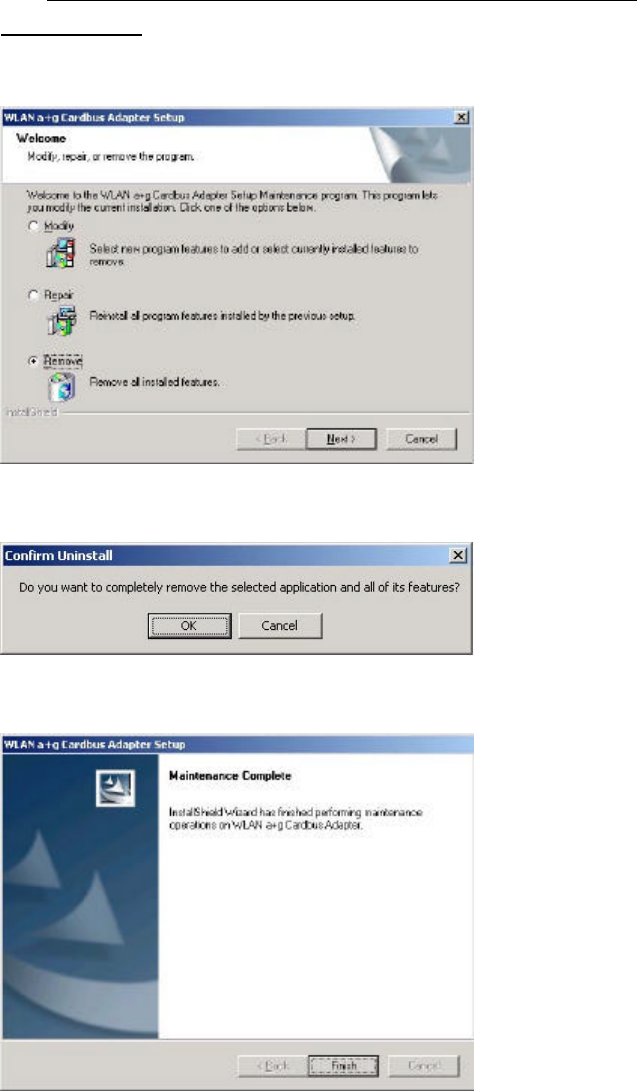
11
2.2 Uninstallation
Note! Before uninstallation, please close all running programs.
1. Click Start>Programs>WLAN a+g Cardbus Adapter>UnInstall WLAN a+g
Cardbus Adapter.
2. Choose “Remove”. Click “Next”.
3. Click “OK” to start Uninstall.
4. Click “Finish”. Uninstall is now completed.
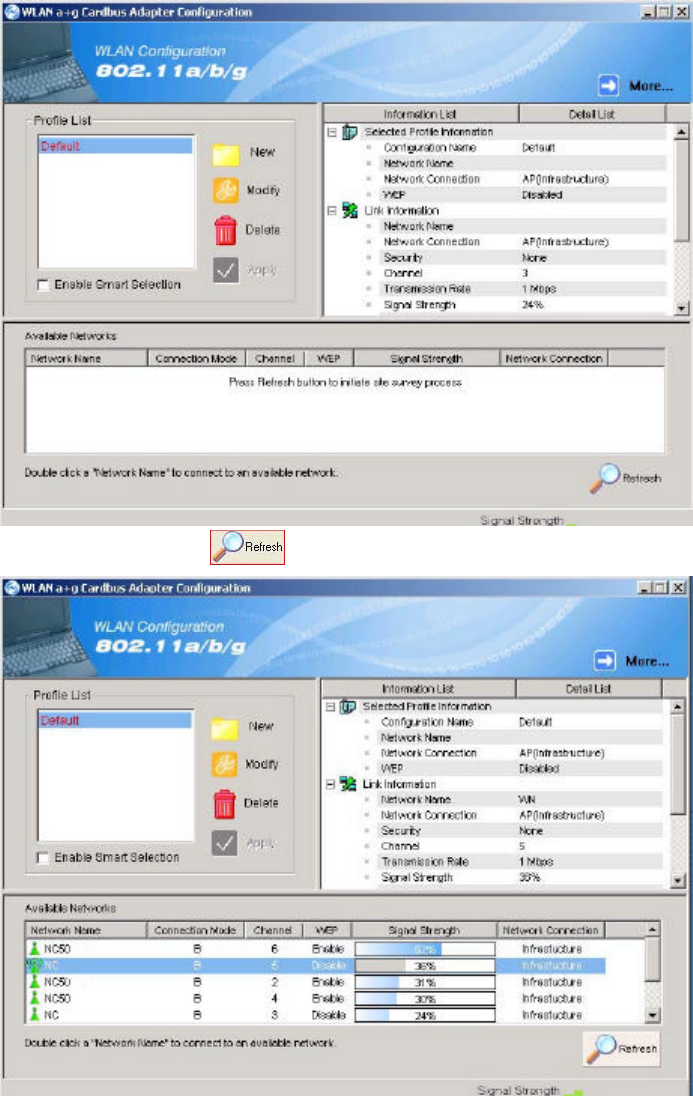
12
3. Connecting to an Existing Network
1. Double click the shortcut icon of “WLAN a+g Cardbus Adapter” on the desktop,
and the “WLAN a+g Cardbus Adapter Configuration” window will appear.
2. Click “Refresh” button , and all available networks will be listed.
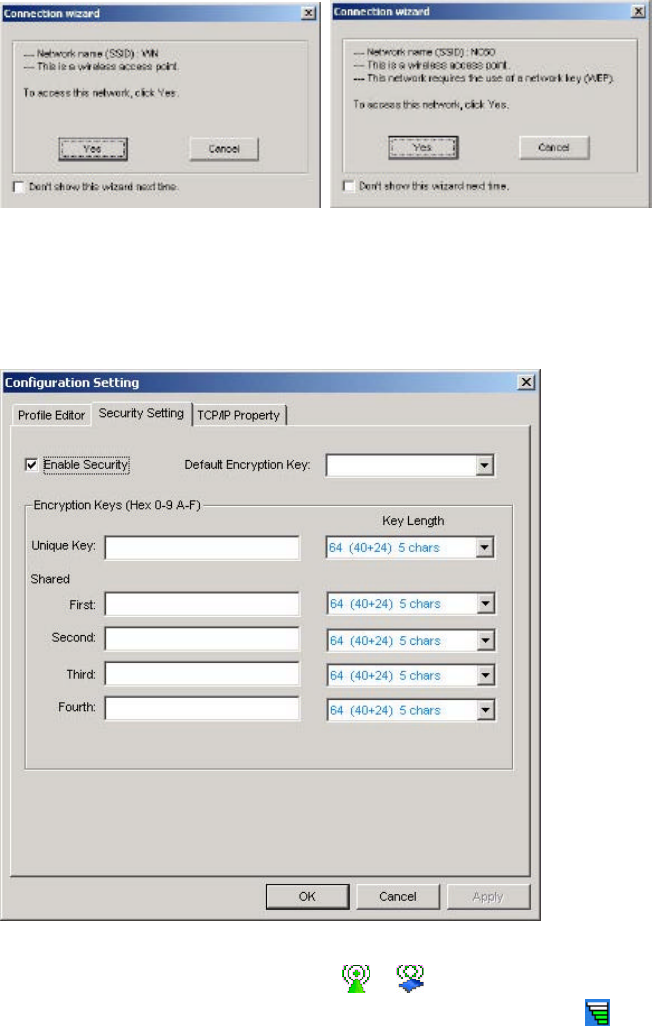
13
3. From the list of “Available Networks”, choose one network by double clicking the
Network Name. One of the following dialog boxes appears. Click “Yes” to
continue.
4. If the WEP of the chosen network is enabled, the “Security Setting” tab is
displayed. Enter the correct Encryption Keys and click “OK”. You need to
contact the network administrator for the values the Encryption Keys.
8. Once connected (when you see the icon or in front of the name of the
Connected Network), you can check the signal strength from the icon in the
Windows System Tray.
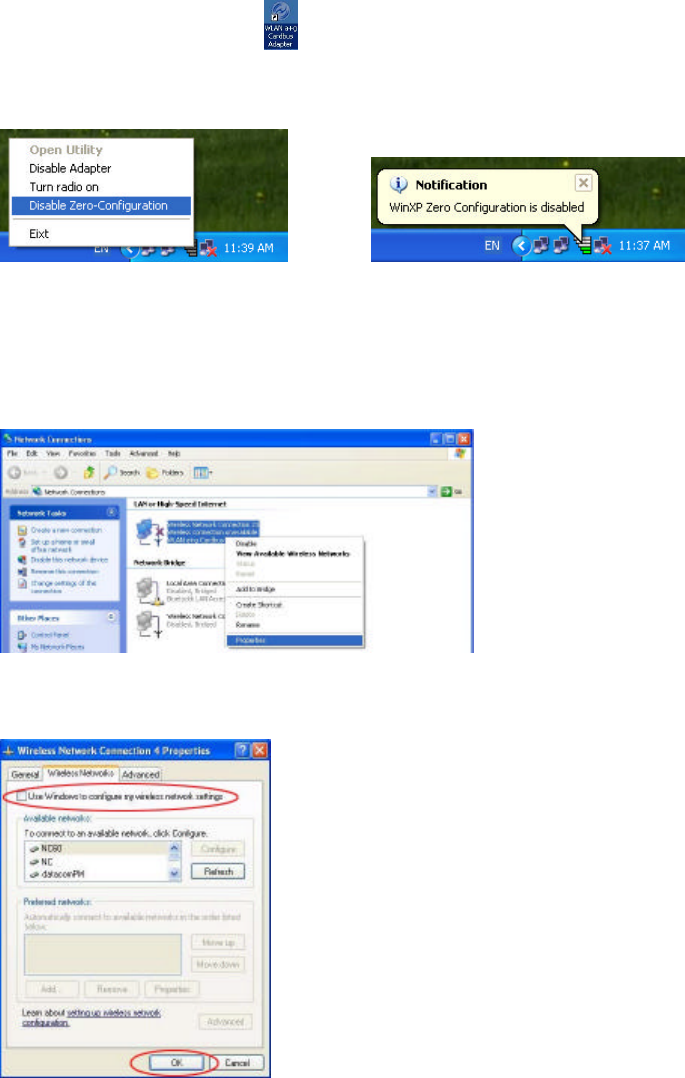
14
3.1 Additional Note for Windows XP
In Windows XP, it is recommended that you use the WLAN a+g Cardbus Adapter
Configuration Utility. Before using the Utility, please follow the steps below to
disable the Windows XP Zero Configuration:
Option 1:
1. Double click the shortcut icon to open the Utility.
2. From the Windows System Tray, you should see the signal icon. Right-click it
and select “Disable Zero-Configuration”.
Option 2:
1. Go to “Control Panel” and double click “Network Connections”.
2. Right-click “Wireless Network Connection” of “WLAN a+g Cardbus Adapter”,
and select “Properties”.
3. Select “Wireless Networks” tab, and uncheck the check box of “Use Windows to
configure my wireless network settings”, and then click “OK”.
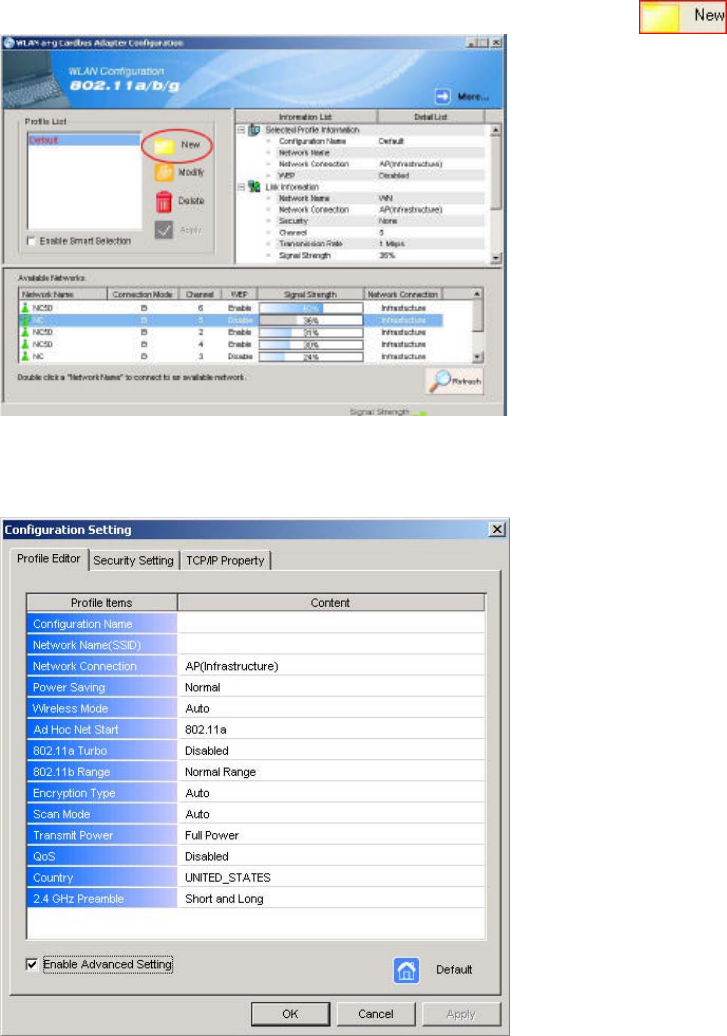
15
4. Creating a New Network
1. In “WLAN a+g Cardbus Adapter Configuration” window, click “New” .
2. Select the “Profile Editor” tab and check the check box of “Enable Advanced
Setting” to edit all settings. Click “OK” to save the settings.
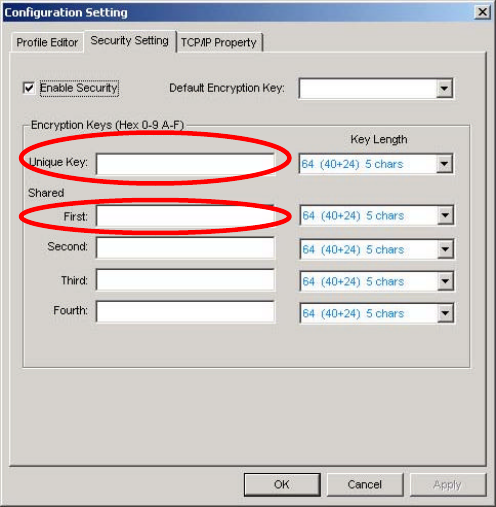
16
3. Click the “Security Setting” tab and set the Encryption Keys. Click “OK” to save
the settings. When you are creating an Infrastructure mode and IEEE802.11b
standard network, please enter a passkey in “Shared Keys: First” field. For
Infrastructure mode and IEEE802.11a standard network, you may enter a
passkey in either “Unique Key” field or “Shared Keys: First” field. If you are
creating an Ad-Hoc mode network, enter a passkey in “Shared Keys: First” field.
4. The new Network Name is then listed in the Profile List.
Note! For details of each setting, please read Chapter 5 “Configuration”.
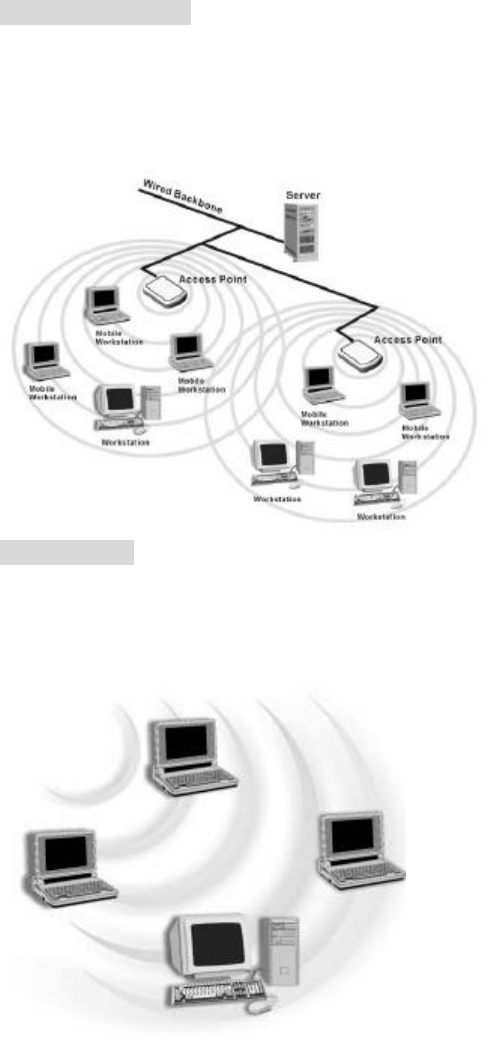
17
5. Configuration
5.1 Device Configuration
You can set the Wireless Network Adapter to work in either “infrastructure” mode or
“ad hoc” mode.
Infrastructure Mode
In infrastructure mode, devices communicate with each other by first going through an
Access Point (AP). Wireless devices can communicate with each other or can
communicate with a wired network. When one AP is connected to wired network and
a set of wireless stations, it is referred to as a BSS (Basic Service Set).
Ad Hoc Mode
Ad-hoc mode is also called “peer-to-peer mode” or “Independent Basic Service Set
(IBSS)”. In ad hoc mode, devices communicate directly with each other without
using an Access Point (AP).
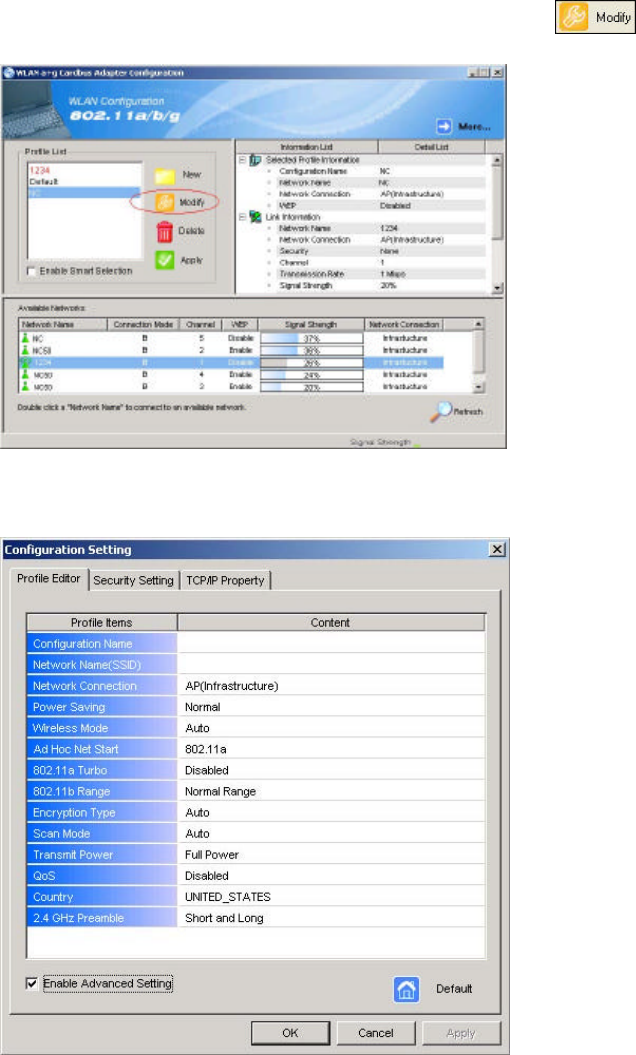
18
5.1.1 Non-Default Settings Configuration
1. Open “WLAN a+g Cardbus Adapter Configuration” by double clicking the
shortcut icon on the desktop.
Note! If there’s no network name listed in the “Profile List”, click “Refresh”
button and double click a Network Name from “Available Networks”.
The chosen Network Name will then be listed in the Profile List.
2. From the Profile List, select one Profile and click “Modify” button .
3. Select “Profile Editor” tab and edit the settings. Click “OK” to save the
modifications.
19
n Configuration Name: This name identifies the configuration. This name
should be unique.
n Network Name (SSID): The name of the wireless network. This name
cannot be longer than 32 characters. If the field is set to be “ANY” or is left
blank, your computer will connect to an AP with the best signal strength.
n Network Connection: Specifies the mode of the network. Two options are
“Infrastructure” and “Ad Hoc”.
n Power Saving: Three power management options are “Off”, “Normal” and
“Maximum”. In Ad Hoc mode, Power Savings function cannot be enabled.
n Wireless Mode: Three options are “802.11b”, “802.11a” or “Auto”.
“Auto” allows the use of either 802.11a or 802.11b mode.
n Ad Hoc Net Start: Specifies a band to establish an Ad Hoc network if no
matching SSID is found. Four options are available: 802.11b, 802.11a,
802.11aTurbo and 802.11g (Pure g).
n 802.11a Turbo: Disables or enables the 802.11a Turbo mode.
n 802.11b Range: Two options are “Normal Range” and “Extended Range”.
n Encryption Type: Three options are “WEP”, “AES” and “Auto”. WEP
stands for Wired Equivalent Privacy, and AES stands for Advanced
Encryption Security. AES provides much higher level of security. “Auto”
allows the Adapter and AP to negotiate the encryption type. If AES is not
available, WEP is used. By default, the Adapter is set to “Auto” and will
attempt to use AES first. If the AP supports WEP only or is configured for
WEP only, the Adapter will automatically use WEP.
n Scan Mode: Three options are “Active Scan”, “Passive Scan” and “Auto”.
n Transmit Power: Five options are “Full Power”, “50% Power”, “25%
Power”, “12% Power” and “Lowest Power”.
n QoS: Stands for Quality of Service. Disables or enables the Adapter to
cooperate in a network using QoS.
n Country: Select the country where you are. Different countries have
different regulations. Please do not illegally use the un-licensed channel.
n 2.4 GHz Preamble: Allows Ad Hoc compatibility with other 2.4 GHz
devices. Two options are “Short and Long” and “Long only”.
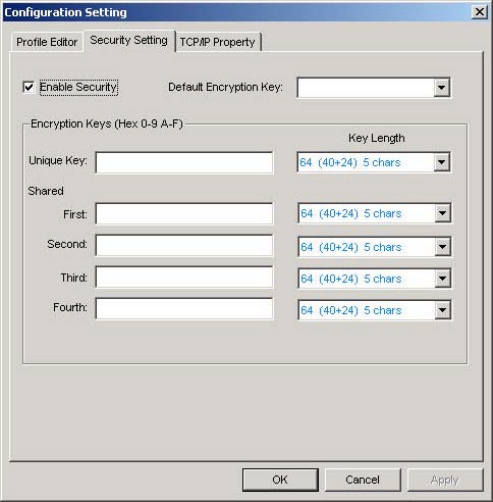
20
4. Select “Security Setting” tab and edit the settings. Click “OK” to save the settings.
n Enable Security: Enables the WEP security when the check box is checked,
and disables the WEP security when the check box is cleared.
n Default Encryption Key: Allows you to choose one type of encryption key
to be used (Unique, First, Second, Third, or Fourth) from the drop down
menu. n Unique Key: Defines the unique encryption key for security for the current
network configuration. Not used in Ad-Hoc mode. To use Unique Key for
security, this field should be populated. To use AES, you must specify a
Unique Key.
n Shared Keys: Defines four shared encryption keys. To use Shared Keys for
security, at least one Shared Key should be populated.
n Key Length: Defines the length of each encryption key. When the length is
changed to be a smaller number after a key is entered, the key is
automatically truncated to fit. If the length is increased again, the key will
not be automatically updated to the previous value.
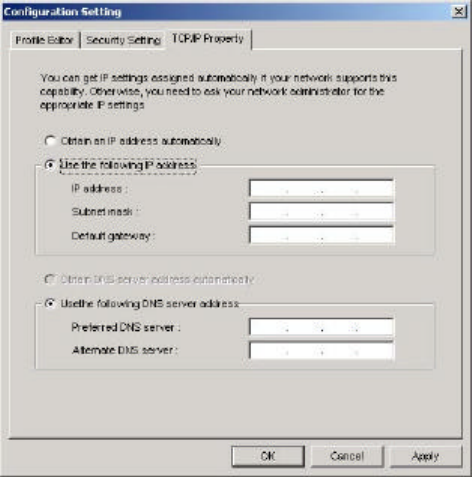
21
5. Select “TCP/IP Property” tab. Enter the settings and click “OK” to save the
settings.
n If the network uses DHCP server, choose “Obtain an IP address automatically”.
n If the network does not use DHCP server, choose “Use the following IP address”
to set the relative settings. For the IP configuration information, please contact
the network administrator.
5.1.2 Default Settings Windows XP Zero-Configuration
You may also choose the default parameters and directly proceed to Windows XP
zero-configuration through the steps below:
1. Go to “Control Panel” and open “Network Connections”.
2. Right-click the Wireless Network Connection of “WLAN a+g Cardbus Adapter”,
and make sure this connection is Enabled.
3. Right-click the Wireless Network Connection of “WLAN a+g Cardbus Adapter”,
and then click “Properties”.
4. Select “Wireless Networks” tab and select “Use Windows to configure my wireless
network settings” check box.
Note! Clear the check box of “Use Windows to configure my wireless network
settings” will disable automatic wireless network configuration.

22
6. Troubleshooting
Problems Possible Solutions
n My computer cannot find the Adapter 1. Make sure the Adapter has no physical
damage.
2. Make sure the Adapter is properly
inserted in the Cardbus slot.
3. Try the Adapter in other Cardbus slots.
4. Try another Adapter in that particular
Cardbus slot.
5. Check whether there are conflicts
caused by other network cards in the
computer: Remove all other cards the
try this Adapter separately.
n Cannot access any network resources
from the computer.
1. Make sure the correct software is
installed.
2. Uninstall and reinstall the driver/utility
(see Chapter 2 for the procedures).
3. Make sure all network devices are
receiving power and working well.
4. Check whether the SSID is set
properly.
5. Check with the network administrator
to see whether the Access Point is
configured properly to accept your
signal.
6. If you have trouble accessing the
Internet, make sure to check with the
ISP (Internet Service Provider) for
further instructions.